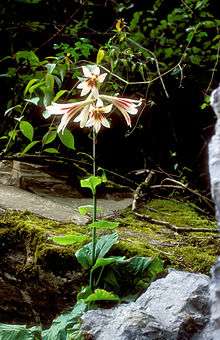Lilioideae
| Lilioideae | |
|---|---|
 | |
| Cardiocrinum giganteum | |
| Scientific classification | |
| Kingdom: | Plantae |
| (unranked): | Angiosperms |
| (unranked): | Monocots |
| Order: | Liliales |
| Family: | Liliaceae |
| Subfamily: | Lilioideae Eaton[1] |
| Genera | |
| Synonyms | |
|
Erythroniaceae Martynov | |
The Lilioideae are a subfamily of monocotyledon perennial, herbaceous mainly bulbous flowering plants in the Liliaceae (Lily) family. They are found predominantly in the temperate and colder regions of the Northern Hemisphere, particularly East Asia and North America. The subfamily includes two tribes. They are of economic importance, particularly the lilies and tulips.
Description
Lilliodeae genera are relatively homogeneous and distinct from the other two Liliaceae subfamilies (Calochortoideae and Streptopoideae). They are perennial herbaceous flowering plants that are mainly bulbous (Lilieae) with contractile roots, but may be rhizomatous (Medeoleae). Stems unbranched, leaves with parallel venation. Flowers are large and showy. The embryo sac (megagametophyte) is of the Fritillaria-type (tetrasporic). Capsule septicidal, seeds often flattened, exotesta pallisaded or lignified. The seeds of Medeoleae are striate.[2] Chromosome number may be 7 (Medeoleae),[3] 9, or 11-14, with a highly variable length (2.2 - 27 µm).
Taxonomy
The term was introduced by Amos Eaton in his Botanical Dictionary in 1836.[4] Engler and Prantl included it as one of the eleven subfamilies of Liliaceae.[5] In 1927, Buxbaum's treatment of the subfamily included three tribes; Lloydieae (Gagea, Lloydia and Szechenya and Giradiella — both now included in Lloydia), Tulipeae: (Erythronium, Tulipa and Eduardoregalia — now part of Tulipa) and Lilieae (Korolkowia, Fritillaria, Notholirion, Cardiocrinum, Nomocharis and Lilium).[6][7]
In the phylogenetic era, the Lilioideae subfamily has been circumscribed in both a broad (sensu lato, or s.l.) and narrow (senso stricto, or s.s.) sense. Tamura,[8] and others[9] have defined Lilioideae s.s. (or sensu Tamura) to include only the tribes Tulipeae and Lilieae. However other authorities including the Angiosperm Phylogeny Website (APWeb)[10] define Lilioideae s.l. to also include the Medeoleae (while subsuming the Tulipae into Lilieae). In the s.s. usage, the Medeoleae are treated as a separate subfamily, the Medeoloideae.
Genera
The Lilioideae subfamily includes ten genera and about 535 species. The largest genera are Gagea (200), Fritillaria (130), Lilium (110), and Tulipa (75 species).
References
- ↑ 1836. Bot. Dict., ed. 4: 27
- ↑ Mabberley, David J (2013). Mabberley's Plant-Book (3 ed.). Cambridge University Press. ISBN 1107782597. Retrieved 8 January 2014.
- ↑ Hayashi, Kazuhiko; Seiji Yoshida; Frederick H. Utech; Shoichi Kawano (2001). "Molecular systematics in the genus Clintonia and related taxa based on rbcL and matK gene sequence data". Plant Species Biology. 16 (2): 119–137. doi:10.1046/j.1442-1984.2001.00057.x. Retrieved 18 January 2014.
- ↑ Eaton 1836.
- ↑ Engler 1903, Liliiflorae - Liliaceae - Lilioideae p. 96.
- ↑ Buxbaum 1936.
- ↑ Buxbaum 1937.
- ↑ Tamura 1998a, Lilioideae p. 350.
- ↑ Patterson & Givnish 2002.
- ↑ Stevens 2015, Liliaceae.
Bibliography
- Buxbaum, F. (1936). "Die Entwicklungslinien der Lilioideae. I. Die systematische Stellung der gattung Gagea". Botanisches Archiv (in German). 38: 213–293.
- Buxbaum, F. (1937). "Die Entwicklungslinien der Lilioideae. II. Die Wurmbaeoideae". Botanisches Archiv (in German). 38: 305–398.* Tropicos: Lilioideae Eaton
- Eaton, Thomas (1836). Eaton's botanical grammar and dictionary, modernized down to 1836 (4th ed.). Albany: Oliver Steele.
- Engler, Adolf (1903). Syllabus der Pflanzenfamilien : eine Übersicht über das gesamte Pflanzensystem mit Berücksichtigung der Medicinal- und Nutzpflanzen nebst einer Übersicht über die Florenreiche und Florengebiete der Erde zum Gebrauch bei Vorlesungen und Studien über specielle und medicinisch-pharmaceutische Botanik. Berlin: Borntraeger. Retrieved 5 February 2014.
- Schnarf, Karl (September 1948). "Der Umfang der Lilioideae im natürlichen System". Österreichische Botanische Zeitschrift. Wien: Springer. 95 (3): 257–269. doi:10.1007/BF01249968. ISSN 0378-2697.
- Tamura, M. N. Liliaceae. pp. 343–353. doi:10.1007/978-3-662-03533-7_41. In Kubitzki & Huber (1998).
- Kubitzki, Klaus; Huber, Herbert, eds. (1998). The families and genera of vascular plants. Vol.3. Flowering plants. Monocotyledons: Lilianae (except Orchidaceae). Berlin, Germany: Springer-Verlag. ISBN 3-540-64060-6. Retrieved 14 January 2014.
- Patterson, T. B.; Givnish, T. J. (2002). "Phylogeny, concerted convergence, and phylogenetic niche conservatism in the core Liliales: insights from rbcL and ndhF sequence data" (PDF). Evolution. 56 (2): 233–252. doi:10.1111/j.0014-3820.2002.tb01334.x. PMID 11926492. Archived from the original (PDF) on April 21, 2004. Retrieved 14 January 2014.
- Stevens, P.F. (2015) [1st. Pub. 2001], Angiosperm Phylogeny Website, Missouri Botanical Garden, retrieved 13 April 2015
| Wikimedia Commons has media related to Lilioideae. |
| Wikispecies has information related to: Lilioideae |